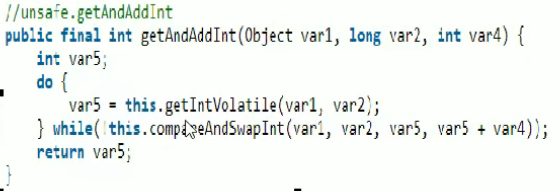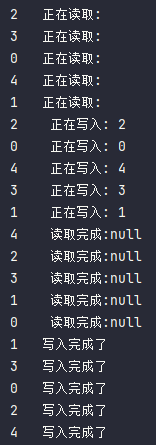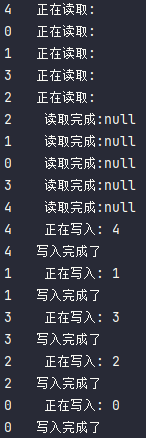6.1 公平和非公平锁
6.1.1 是什么
package s02.e06;import java.util.concurrent.locks.Lock;import java.util.concurrent.locks.ReentrantLock;public class T1 {volatile int n = 0;public void add() {n++;}public static void main(String[] args) {Lock lock = new ReentrantLock();}}

公平锁―是指多个线程按照申请锁的顺序来获取锁,类似排队打饭,先来后到。
非公平锁是指多个线程获取锁的顺序并不是按照申请锁的顺序,有可能后中请的线程比先中请的线程优先获取锁。
在高并发的情况下,有可能会造成优先级反转或者饥饿现象。
6.1.2 两者区别
- 公平锁:Threads acquire a fair lock in the order in which they requested it
公平锁,就是很公平,在并发环境中,每个线程在获取锁时会先查看此锁维护的等待队列,如果为空,或者当前线程是等待队列的第一个,就占有锁,否则就会加入到等待队列中,以后会按照 FIFO 的规则从队列中取到自己
- 非公平锁:a nonfair lock permits barging: threads requesting a lock can jump ahead of the queue of waiting threads if the lockhappens to be available when it is requested.
非公平锁比较粗鲁,上来就直接尝试占有锁,如果尝试失败,就再采用类似公平锁那种方式。
6.1.3 题外话
Java ReentrantLock,通过构造函数指定该锁是否是公平锁,默认是非公平锁。非公平锁的优点在于吞吐量比公平锁大。
Synchronized 也是一种非公平锁
6.2 可重入锁(又名递归锁)
6.1.1 是什么
指的是同一线程外层函数获得锁之后﹐内层递归函数仍然能获取该锁的代码,在同一个线程在外层方法获取锁的时候,在进入内层方法会自动获取锁。
也即是说,线程可以进入任何一个它已经拥有的锁所同步着的代码块。
ReentrantLock/Synchronized 就是一个典型的可重入锁
可重入锁最大的作用是避免死锁
6.1.2 Synchronized
package s02.e06;class Phone {public synchronized void sendSMS() throws Exception {System.out.println(Thread.currentThread().getName() + "\t invoked sendSMS()");sendEmail();}public synchronized void sendEmail() throws Exception {System.out.println(Thread.currentThread().getName() + "\t #######invoked sendEmai()");}}public class ReentrantLockDemo {public static void main(String[] args) {Phone phone = new Phone();new Thread(() -> {try {phone.sendSMS();} catch (Exception e) {e.printStackTrace();}}, "t1").start();new Thread(() -> {try {phone.sendSMS();} catch (Exception e) {e.printStackTrace();}}, "t2").start();}}

通过上面示例我们可以看出,t1 线程在外层方法获取锁的时候,t1 在进入内层方法会自动获取锁
6.1.3 ReentrantLock
package s02.e06;import java.util.concurrent.locks.Lock;import java.util.concurrent.locks.ReentrantLock;class Phone implements Runnable {Lock lock = new ReentrantLock();@Overridepublic void run() {get();}public void get() {lock.lock();try {System.out.println(Thread.currentThread().getName() + "\t invoked get()");set();} finally {lock.unlock();}}public void set() {lock.lock();try {System.out.println(Thread.currentThread().getName() + "\t #######invoked set()");} finally {lock.unlock();}}}public class ReentrantLockDemo {public static void main(String[] args) {Phone phone = new Phone();Thread t3 = new Thread(phone, "t3");Thread t4 = new Thread(phone, "t4");t3.start();t4.start();}}

package s02.e06;import java.util.concurrent.locks.Lock;import java.util.concurrent.locks.ReentrantLock;class Phone implements Runnable {Lock lock = new ReentrantLock();@Overridepublic void run() {get();}public void get() {lock.lock();lock.lock(); // 多加一层锁try {System.out.println(Thread.currentThread().getName() + "\t invoked get()");set();} finally {lock.unlock();lock.unlock();}}public void set() {lock.lock();try {System.out.println(Thread.currentThread().getName() + "\t #######invoked set()");} finally {lock.unlock();}}}public class ReentrantLockDemo {public static void main(String[] args) {Phone phone = new Phone();Thread t3 = new Thread(phone, "t3");Thread t4 = new Thread(phone, "t4");t3.start();t4.start();}}
6.3 自旋锁(spinlock)
是指尝试获取锁的线程不会立即阻塞,而是采用循环的方式去尝试获取锁,这样的好处是减少线程上下文切换的消耗,缺点是循环会消耗 CPU
通过 CAS 操作完成自旋锁,A 线程先进来调用 myLock 方法自己持有锁 5 秒钟,B 随后进来后发现当前有线程持有锁,不是 null,所以只能通过自旋等待,直到 A 释放锁后B随后抢到。
package s02.e06;import java.util.concurrent.TimeUnit;import java.util.concurrent.atomic.AtomicReference;public class SpinLockDemo {// 原子引用线程AtomicReference<Thread> atomicReference = new AtomicReference<>();public void myLock() {Thread thread = Thread.currentThread();System.out.println(Thread.currentThread().getName() + "\t come in o(n_n)o");while (!atomicReference.compareAndSet(null, thread)) {}}public void myUnlock() {Thread thread = Thread.currentThread();atomicReference.compareAndSet(thread, null);System.out.println(Thread.currentThread().getName() + "\t invoked myUnLock()");}public static void main(String[] args) {SpinLockDemo spinLockDemo = new SpinLockDemo();new Thread(() -> {spinLockDemo.myLock();// 暂停一会儿线程try {TimeUnit.SECONDS.sleep(5);} catch (InterruptedException e) {e.printStackTrace();}spinLockDemo.myUnlock();}, "AA").start();try {TimeUnit.SECONDS.sleep(1);} catch (InterruptedException e) {e.printStackTrace();}new Thread(() -> {spinLockDemo.myLock();try {TimeUnit.SECONDS.sleep(1);} catch (InterruptedException e) {e.printStackTrace();}spinLockDemo.myUnlock();}, "BB").start();}}
6.4 独占锁(写锁)/共享锁(读锁)/互斥锁
独占锁:指该锁一次只能被一个线程所持有。对 ReentrantLock 和 Synchronized 而言都是独占锁
共享锁:指该锁可被多个线程所持有。对 ReentrantReadWriteLock 其读锁是共享锁,其写锁是独占锁。
读锁的共享锁可保证并发读是非常高效的,读写,写读,写写的过程是互斥的。
多个线程同时读一个资源类没有任何问题,所以为了满足并发量,读取共享资源应该可以同时进行。但是如果有一个线程想去写共享资源来,就不应该再有其它线程可以对该资源进行读或写
小总结:
- 读-读能共存
- 读-写不能共存
- 写-写不能共存
- 写操作:原子 + 独占,整个过程必须是一个完整的统一体,中间不许被分割,被打断 ```java package s02.e06;
import java.util.HashMap; import java.util.Map; import java.util.concurrent.TimeUnit;
// 资源类
class Mycache {
private volatile Map
// private Lock lock=new ReentrantLock();public void put(String key, Object value) {System.out.println(Thread.currentThread().getName() + "\t 正在写入: " + key);// 暂停一会儿线程try {TimeUnit.MILLISECONDS.sleep(300);} catch (InterruptedException e) {e.printStackTrace();}map.put(key, value);System.out.println(Thread.currentThread().getName() + "\t写入完成了");}public void get(String key) {System.out.println(Thread.currentThread().getName() + "\t正在读取:");// 暂停一会儿线程try {TimeUnit.MILLISECONDS.sleep(300);} catch (InterruptedException e) {e.printStackTrace();}Object result = map.get(key);System.out.println(Thread.currentThread().getName() + "\t 读取完成:" + result);}
}
public class ReadWriteLockDemo { public static void main(String[] args) { Mycache mycache = new Mycache();
for (int i = 0; i < 5; i++) {final int tempInt = i;new Thread(() -> {mycache.put(tempInt + "", tempInt + "");}, String.valueOf(i)).start();}for (int i = 0; i < 5; i++) {final int tempInt = i;new Thread(() -> {mycache.get(tempInt + "");}, String.valueOf(i)).start();}}
}
<br />在不加锁的情况下,写入操作被打断,完全违背了原子性```javapackage s02.e06;import java.util.HashMap;import java.util.Map;import java.util.concurrent.TimeUnit;import java.util.concurrent.locks.ReentrantReadWriteLock;// 资源类class Mycache {private volatile Map<String, Object> map = new HashMap<>();private ReentrantReadWriteLock rwLock = new ReentrantReadWriteLock();// private Lock lock=new ReentrantLock();public void put(String key, Object value) {rwLock.writeLock().lock();try {System.out.println(Thread.currentThread().getName() + "\t 正在写入: " + key);// 暂停一会儿线程try {TimeUnit.MILLISECONDS.sleep(300);} catch (InterruptedException e) {e.printStackTrace();}map.put(key, value);System.out.println(Thread.currentThread().getName() + "\t写入完成了");} catch (Exception e) {e.printStackTrace();} finally {rwLock.writeLock().unlock();}}public void get(String key) {rwLock.readLock().lock();try {System.out.println(Thread.currentThread().getName() + "\t正在读取:");// 暂停一会儿线程try {TimeUnit.MILLISECONDS.sleep(300);} catch (InterruptedException e) {e.printStackTrace();}Object result = map.get(key);System.out.println(Thread.currentThread().getName() + "\t 读取完成:" + result);} catch (Exception e) {e.printStackTrace();} finally {rwLock.readLock().unlock();}}}public class ReadWriteLockDemo {public static void main(String[] args) {Mycache mycache = new Mycache();for (int i = 0; i < 5; i++) {final int tempInt = i;new Thread(() -> {mycache.put(tempInt + "", tempInt + "");}, String.valueOf(i)).start();}for (int i = 0; i < 5; i++) {final int tempInt = i;new Thread(() -> {mycache.get(tempInt + "");}, String.valueOf(i)).start();}}}

通过读写锁,保证写入操作的原子性和读取操作的高并发性



